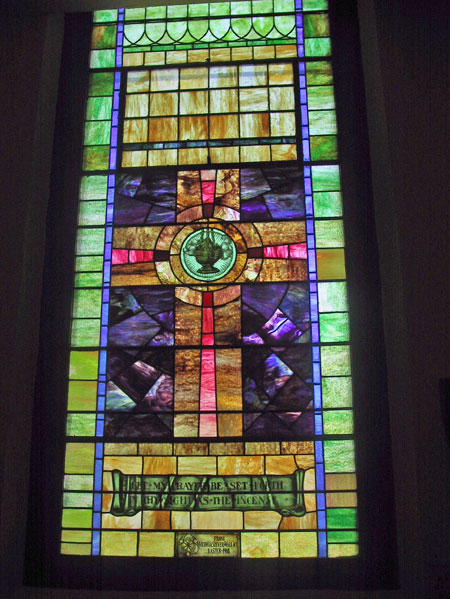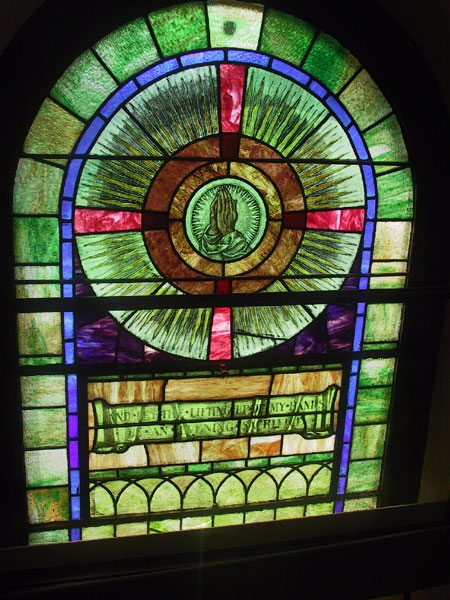
Subject: Thurible
Inscription: “Let My Prayer Be Set Forth In Thy Sight As The Incense”
Dedication: From Victoria Stevens Wallace
Maker/Date: Charles Hogeman, Easter, 1908
Lower Description – The scripture is from Psalm 141:2
“Let My Prayer Be Set Forth In Thy Sight As The Incense”
David under suspicion, half afraid to speak lest he should speak unadvisedly while trying to clear himself; David slandered and beset by enemies; David censured even by saints, and taking it kindly; David deploring the condition of the godly party of whom he was the acknowledged heard: David waiting upon God with confident expectation. The Psalm is one of a group of four, and it bears a striking likeness to the other three. In its commencement the psalm is lighted up with the evening glow as the incense rises to heaven; then comes a night of language whose meaning we cannot see; and this gives place to morning light in which our eyes are unto the Lord.
Let my prayer be set forth before thee as incense. As incense is carefully prepared, kindled with holy fire, and devoutly presented unto God, so let my prayer be. We are not to look upon prayer as easy work requiring no thought. It needs to be “set forth”; what is more, it must be set forth “before the Lord, “by a sense of his presence and a holy reverence for his name: neither may we regard all supplication as certain of divine acceptance, it needs to be set forth before the Lord “as incense, “concerning the offering of which there were rules to be observed, otherwise it would be rejected of God.
Techniques The Wallace windows use similar glass around a center symbols arranged in five rows of stone with the central theme in the middle. Surrounding the symbol are two concentric circles of stones. Within each row are different shapes of glass. The effect is traditional without any special treatment of the glass or painting
Symbol – Thurible
A thurible is a metal suspended from chains, in which is burned during services
The workings of a thurible are quite simple. Burning charcoal is inside the metal . , sometimes of many different varieties, is placed upon the charcoal. This may be done several times during the service as the incense burns quite quickly. Once the incense has been placed on the charcoal the thurible is then closed and used for censing.
Traditionally, at High Mass, the following rule is observed when censing, which differs from the common Roman Rite:
- Three sets of triple swings: When censing the
- Three sets of double swings: When censing images, relics, and other sacramentals, also when censing the celebrant.
- Two sets of double swings: When censing a Deacon.
- One set of double swings: When censing a Sub-Deacon.
- Three sets of single swings: When censing the congregation
In churches, the Thurible is carried in procession in front of the and . The Celebrant then censes the altar on which the Eucharist is to be offered, in the following form (at a Nave Altar):
- After venerating the altar, the Priest receives the thurible from the server at the North end of the altar.
- The Priest circles the altar, making small movements in the thurible, in an anti-clockwise direction until s/he reaches the west side of the altar, facing east.
- The Priest then makes three sets of triple swings towards east, then continues around the altar to his/her original position facing west.
This same pattern is followed when censing the altar at the offertory, with the following prequel:
- The Priest makes 6 swings (3+3) over the gifts, making the sign of the cross.
- The Priest then makes 3 circles, two counter-clockwise and one clockwise, over and around the gifts.
At the Gospel, the deacon (or whoever is reading the Gospel) censes following the introduction to the Gospel (i.e.: Hear the Gospel of our Lord Jesus Christ according to… ) using three sets of double swings, one set South, one set North, and one set west.

Upper Subject:Hands in Prayer
Inscription: “And The Lifting Up Of My Hands Be As An Evening Sacrifice”
Description –
“And The Lifting Up Of My Hands Be As An Evening Sacrifice”
The scripture is also from Psalm 141:2
It is the next verse after the lower one
And the lifting up of my hands as the evening sacrifice. Whatever form his prayer might take his one desire was that it might be accepted of God. Prayer is sometimes presented without words by the very motions of our bodies: bent knees and lifted hands are the tokens of earnest, expectant prayer. Certainly work, or the lifting up of the hands in labour, is prayer if it be done in dependence upon God and for his glory: there is a hand prayer as well as a heart prayer, and our desire is that tiffs may be sweet unto the Lord as the sacrifice of eventide. Holy hope, the lifting up of hands that hang down, is also a kind of worship: may it ever be acceptable with God. The Psalmist makes a bold request: he would have his humble cries and prayers to be as much regarded of the Lord as the appointed morning and evening sacrifices of the holy place. Yet the prayer is by no means too bold, for, after all, the spiritual is in the Lord’s esteem higher than the ceremonial, and the calves of the lips are a truer sacrifice than the calves of the stall. So far we have a prayer about prayer: we have a distinct supplication in the two following verses.
